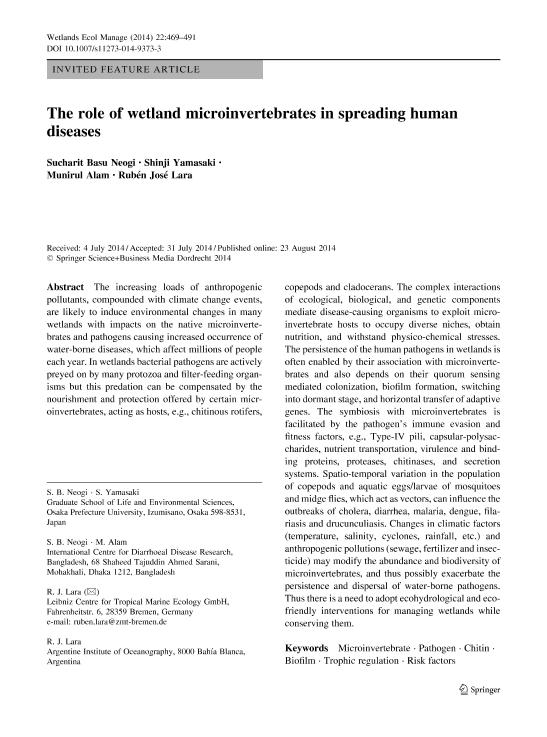Mostrar el registro sencillo del ítem
dc.contributor.author
Neogi, Sucharit Basu
dc.contributor.author
Yamasaki, Shinji
dc.contributor.author
Alam, Munirul
dc.contributor.author
Lara, Ruben Jose

dc.date.available
2017-01-16T17:44:37Z
dc.date.issued
2014-08
dc.identifier.citation
Neogi, Sucharit Basu; Yamasaki, Shinji; Alam, Munirul; Lara, Ruben Jose; The role of wetland microinvertebrates in spreading human diseases; Springer; Wetlands Ecology And Management; 22; 5; 8-2014; 469-491
dc.identifier.issn
0923-4861
dc.identifier.uri
http://hdl.handle.net/11336/11386
dc.description.abstract
The increasing loads of anthropogenic pollutants, compounded with climate change events, are likely to induce environmental changes in many wetlands with impacts on the native microinvertebrates and pathogens causing increased occurrence of water-borne diseases, which affect millions of people each year. In wetlands bacterial pathogens are actively preyed on by many protozoa and filter-feeding organisms but this predation can be compensated by the nourishment and protection offered by certain microinvertebrates, acting as hosts, e.g., chitinous rotifers, copepods and cladocerans. The complex interactions of ecological, biological, and genetic components mediate disease-causing organisms to exploit microinvertebrate hosts to occupy diverse niches, obtain nutrition, and withstand physico-chemical stresses. The persistence of the human pathogens in wetlands is often enabled by their association with microinvertebrates and also depends on their quorum sensing mediated colonization, biofilm formation, switching into dormant stage, and horizontal transfer of adaptive genes. The symbiosis with microinvertebrates is facilitated by the pathogen’s immune evasion and fitness factors, e.g., Type-IV pili, capsular-polysaccharides, nutrient transportation, virulence and binding proteins, proteases, chitinases, and secretion systems. Spatio-temporal variation in the population of copepods and aquatic eggs/larvae of mosquitoes and midge flies, which act as vectors, can influence the outbreaks of cholera, diarrhea, malaria, dengue, filariasis and drucunculiasis. Changes in climatic factors (temperature, salinity, cyclones, rainfall, etc.) and anthropogenic pollutions (sewage, fertilizer and insecticide) may modify the abundance and biodiversity of microinvertebrates, and thus possibly exacerbate the persistence and dispersal of water-borne pathogens. Thus there is a need to adopt ecohydrological and eco-friendly interventions for managing wetlands while conserving them.
dc.format
application/pdf
dc.language.iso
eng
dc.publisher
Springer

dc.rights
info:eu-repo/semantics/openAccess
dc.rights.uri
https://creativecommons.org/licenses/by-nc-sa/2.5/ar/
dc.subject
Pathogens
dc.subject
Chitin
dc.subject
Biofilm
dc.subject
Risk Factors
dc.subject.classification
Ciencias Medioambientales

dc.subject.classification
Ciencias de la Tierra y relacionadas con el Medio Ambiente

dc.subject.classification
CIENCIAS NATURALES Y EXACTAS

dc.title
The role of wetland microinvertebrates in spreading human diseases
dc.type
info:eu-repo/semantics/article
dc.type
info:ar-repo/semantics/artículo
dc.type
info:eu-repo/semantics/publishedVersion
dc.date.updated
2016-12-01T19:39:07Z
dc.journal.volume
22
dc.journal.number
5
dc.journal.pagination
469-491
dc.journal.pais
Alemania

dc.journal.ciudad
Berlin
dc.description.fil
Fil: Neogi, Sucharit Basu. International Centre For Diarrhoeal Disease Research; Bangladesh. Osaka Prefecture University; Japón
dc.description.fil
Fil: Yamasaki, Shinji. Osaka Prefecture University; Japón
dc.description.fil
Fil: Alam, Munirul. International Centre For Diarrhoeal Disease Research; Bangladesh
dc.description.fil
Fil: Lara, Ruben Jose. Consejo Nacional de Investigaciones Científicas y Técnicas. Centro Científico Tecnológico Bahía Blanca. Instituto Argentino de Oceanografía (i); Argentina. Leibniz Centre for Tropical Marine Ecology; Alemania
dc.journal.title
Wetlands Ecology And Management

dc.relation.alternativeid
info:eu-repo/semantics/altIdentifier/url/http://link.springer.com/article/10.1007%2Fs11273-014-9373-3
dc.relation.alternativeid
info:eu-repo/semantics/altIdentifier/doi/http://dx.doi.org/10.1007/s11273-014-9373-3
Archivos asociados
